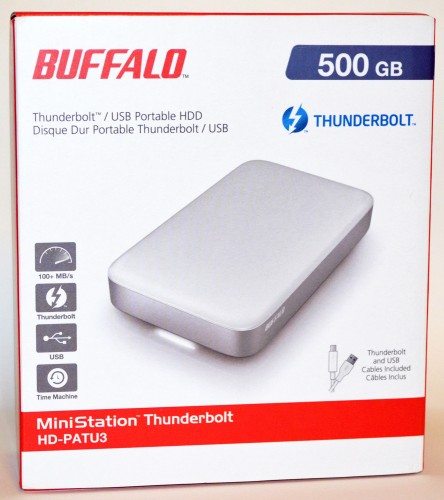 All the Macs we have in our house have Thunderbolt ports on them that don’t really get used, because other than the Thunderbolt Display from Apple, there haven’t been a lot of Thunderbolt accessories on the market for general home use. I did do a review of a Seagate GoFlex Thunderbolt adapter (see related posts at the end of this review), but that disk didn’t operate at true Thunderbolt speeds. I was excited to be selected when Buffalo Tech offered The Gadgeteer one of their MiniStation Thunderbolt (HD-PATU3) external disks for review. Let’s give it a closer look.
All the Macs we have in our house have Thunderbolt ports on them that don’t really get used, because other than the Thunderbolt Display from Apple, there haven’t been a lot of Thunderbolt accessories on the market for general home use. I did do a review of a Seagate GoFlex Thunderbolt adapter (see related posts at the end of this review), but that disk didn’t operate at true Thunderbolt speeds. I was excited to be selected when Buffalo Tech offered The Gadgeteer one of their MiniStation Thunderbolt (HD-PATU3) external disks for review. Let’s give it a closer look.
Click on any image for an enlargement.
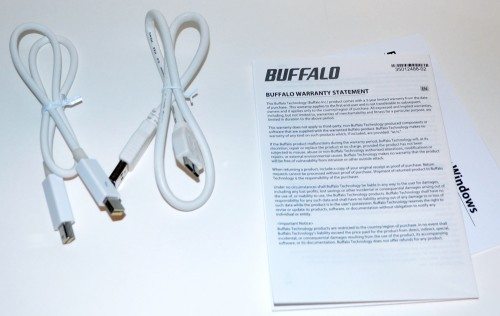 The MiniStation Thunderbolt disk has both a Thunderbolt and a USB 3.0 interface, and it comes with a cable for each. The picture (above) shows the 20″ Thunderbolt cable (left) and the 19.5″ USB 3.0 cable (right), along with a couple of booklets that come with the MiniStation.
The MiniStation Thunderbolt disk has both a Thunderbolt and a USB 3.0 interface, and it comes with a cable for each. The picture (above) shows the 20″ Thunderbolt cable (left) and the 19.5″ USB 3.0 cable (right), along with a couple of booklets that come with the MiniStation.
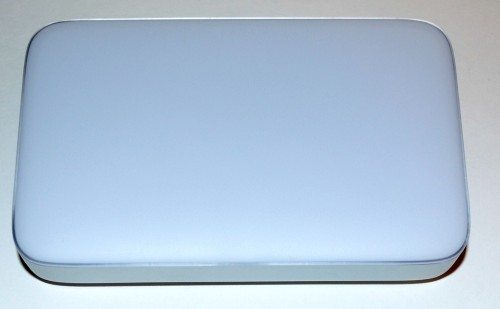 The MiniStation Thunderbolt has a sandblasted aluminum bottom and sides and a frosted white translucent plastic top. It’s available in 500GB or 1TB sizes. I received the 500GB size. It measures 3″ X 5″ X 0.65″ and weighs 8.6 ounces on my digital kitchen scale.
The MiniStation Thunderbolt has a sandblasted aluminum bottom and sides and a frosted white translucent plastic top. It’s available in 500GB or 1TB sizes. I received the 500GB size. It measures 3″ X 5″ X 0.65″ and weighs 8.6 ounces on my digital kitchen scale.
According to the Buffalo Tech site, the MiniStation Thunderbolt is compatible with computers running: Mac OS® X 10.5 – 10.7, Windows® 7 (32/64-bit), Windows Vista® (32/64-bit), Windows® XP, Windows Server® 2003 (32-bit), Windows Server® 2003 R2 (32-bit), Windows Server® 2008 (32/64-bit), Windows Server® 2008 R2 (64-bit). Out of the box, the disk is formatted for use with Mac OS X machines. An instruction sheet walks you through formatting it for use with a Windows computer. Specifications also indicate that the MiniStation Thunderbolt is compatible with Apple’s Time Machine for computer backups.
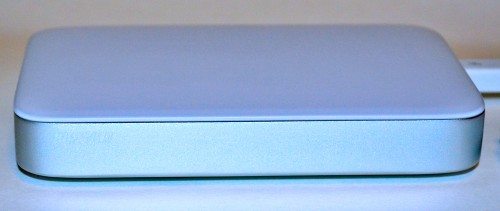 The exterior of the disk is very sleek, with no buttons or lights visible on the top or sides. This shiny aluminum and bright white disk enclosure is one of the hardest things I’ve had to try to photograph. Because of glare and because everything is so similar in color, you can’t see the white Buffalo name screened on the side of the disk in the above picture. You can get a better idea of how it looks from the image on the box (see the lead photo).
The exterior of the disk is very sleek, with no buttons or lights visible on the top or sides. This shiny aluminum and bright white disk enclosure is one of the hardest things I’ve had to try to photograph. Because of glare and because everything is so similar in color, you can’t see the white Buffalo name screened on the side of the disk in the above picture. You can get a better idea of how it looks from the image on the box (see the lead photo).
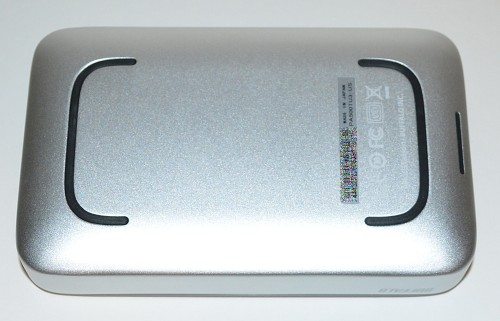 The two black C shapes on the bottom are rubber feet. The black bar on the right side conceals a white light that indicates when the disk is powered or accessed.
The two black C shapes on the bottom are rubber feet. The black bar on the right side conceals a white light that indicates when the disk is powered or accessed.
Speaking of power, the MiniStation Thunderbolt is bus powered, so there’s no AC adapter included or required.
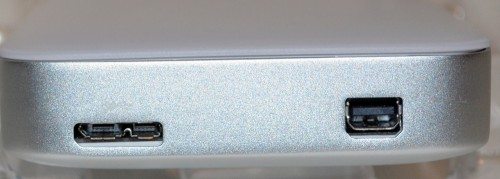 One end has the USB 3.0 port (left) and the Thunderbolt port (right).
One end has the USB 3.0 port (left) and the Thunderbolt port (right).
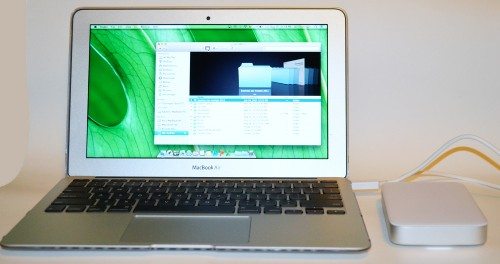 Here you can see it connected to my daughter’s MacBook Air. I used this computer for my testing because it has both a Thunderbolt port and a USB 3.0 port. Again, it’s hard to see in my picture, but you can just make out a white light reflecting off the white table under the front of the disk. The disk’s light is very subtle, and it won’t distract you or blind you.
Here you can see it connected to my daughter’s MacBook Air. I used this computer for my testing because it has both a Thunderbolt port and a USB 3.0 port. Again, it’s hard to see in my picture, but you can just make out a white light reflecting off the white table under the front of the disk. The disk’s light is very subtle, and it won’t distract you or blind you.
The disk is also very quiet. I didn’t hear the disk at all when it was connected to the computer. I did notice that both the disk and the cables got pretty hot while I was performing all these tests and while I was using it to transfer 110GB of data from my laptop to my Mac Mini server. I actually stood the disk up on one of its sides while I was using it; that position exposed more of the metal body to the air for cooling.
According to an article at Computer World, Thunderbolt should operate at twice the speed of USB 3.0. The MiniStation box doesn’t mention USB 3.0 in the speed chart on its back at all. The product page at Buffalo does say that the Thunderbolt interface has a max speed of 10Gbps, while the USB 3.0 interface has a max speed of 5Gbps – just as you’d expect. A footnote on the Buffalo page says “Speeds shown represent maximum interface connection speeds. Actual device transfer speeds will vary based on hard drive specifications and host devices.”
To begin, I ran some tests using the Xbench Comprehensive Macintosh Benchmarking app to measure disk performance with the two cables.
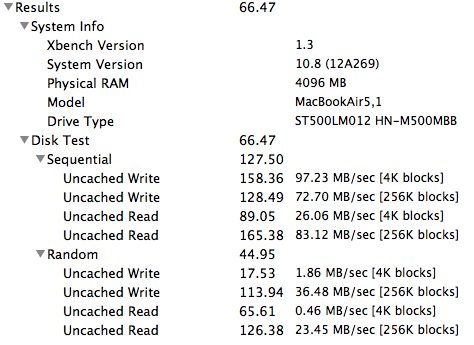 The first set of data (above) is for the MiniStation Thunderbolt disk using the Thunderbolt cable and the MacBook Air.
The first set of data (above) is for the MiniStation Thunderbolt disk using the Thunderbolt cable and the MacBook Air.
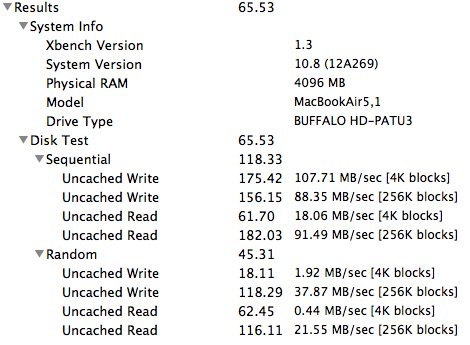
The second set of data (above) is for the MiniStation Thunderbolt disk using the USB 3.0 cable and the MacBook Air. The Xbench application performed a series of sequential and random uncached read and write tests. If you compare the sequential uncached write speeds for both tests, for example, you’ll see the values are very close for both interfaces/cables.
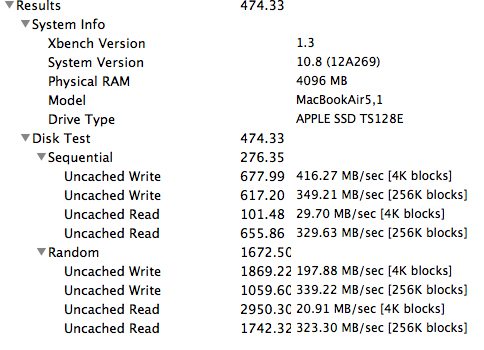 Just as a comparison, these test results are for the SSD in the MacBook Air. You can see from the benchmarks, the SSD shouldn’t be the limiting factor in the file transfer tests I’ll perform.
Just as a comparison, these test results are for the SSD in the MacBook Air. You can see from the benchmarks, the SSD shouldn’t be the limiting factor in the file transfer tests I’ll perform.
 Next, I tried some speed tests copying files between the MacBook Air with its SSD and the Buffalo MiniStation Thunderbolt using each of the interface cables. One set of tests used a single 1.83GB file; the other set used a 3.16GB folder with 1,018 files in it. I did writes to the MiniStation from the Air and to the Air from the MiniStation. You can see from the values above that the speeds were virtually the same, regardless of which cable/interface was used.
Next, I tried some speed tests copying files between the MacBook Air with its SSD and the Buffalo MiniStation Thunderbolt using each of the interface cables. One set of tests used a single 1.83GB file; the other set used a 3.16GB folder with 1,018 files in it. I did writes to the MiniStation from the Air and to the Air from the MiniStation. You can see from the values above that the speeds were virtually the same, regardless of which cable/interface was used.
It seems to me, based on these tests at least, that the MiniStation Thunderbolt isn’t a true Thunderbolt disk. It seems that it operates more like a USB 3.0 disk with a built-in Thunderbolt adapter. And seeing these test results makes the purpose of the footnote about Thunderbolt speeds a little clearer.
Another caveat is that the MiniStation Thunderbolt disk can’t act as a pass-through device in the Thunderbolt daisy-chain. It must be either the only thing connected to the computer’s Thunderbolt port or it must be the last thing in the chain.
Even though you don’t get Thunderbolt speeds, the Thunderbolt adapter does work at least as well as the USB 3.0 interface. This is a bonus for people who own Airs with only a couple of USB ports, or for people who don’t have USB 3.0 ports and who don’t want the disk to have to fall back to the USB 2.0 speeds.
Product Information
| Price: | $180 - $210, depending on retailer |
| Manufacturer: | Buffalo Tech |
| Retailer: | See Buffalo dealer page |
| Pros: |
|
| Cons: |
|
Filed in categories: Desktop Computer Gear, Laptops and Gear, Reviews
Tagged: External disk, Thunderbolt disk, USB 3.0 disk
Buffalo MiniStation Thunderbolt Disk Review originally appeared on The Gadgeteer on August 27, 2012 at 11:00 am.
Source: http://the-gadgeteer.com/2012/08/27/buffalo-ministation-thunderbolt-disk-review/
iPad Jailbreak Jailbreak iPad Jailbreak iPad 3 iPad 3 Jailbreak New iPad Jailbreak Jailbreak New iPad Jailbreak iPad 2 iPad 2 Jailbreak iPad Jailbreak Jailbreak iPad Jailbreak iPad 3 iPad 3 Jailbreak New iPad Jailbreak Jailbreak New iPad Jailbreak iPad 2 iPad 2 Jailbreak iPad Jailbreak Jailbreak iPad Jailbreak iPad 3 iPad 3 Jailbreak
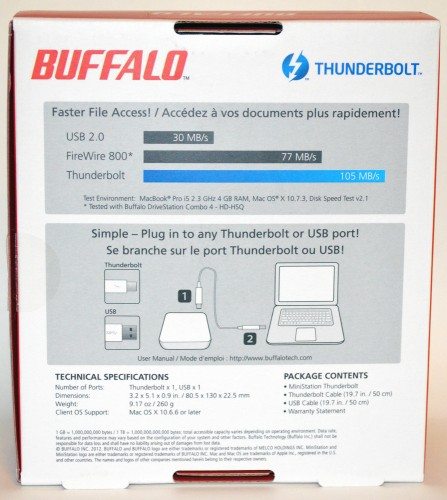
No hay comentarios:
Publicar un comentario